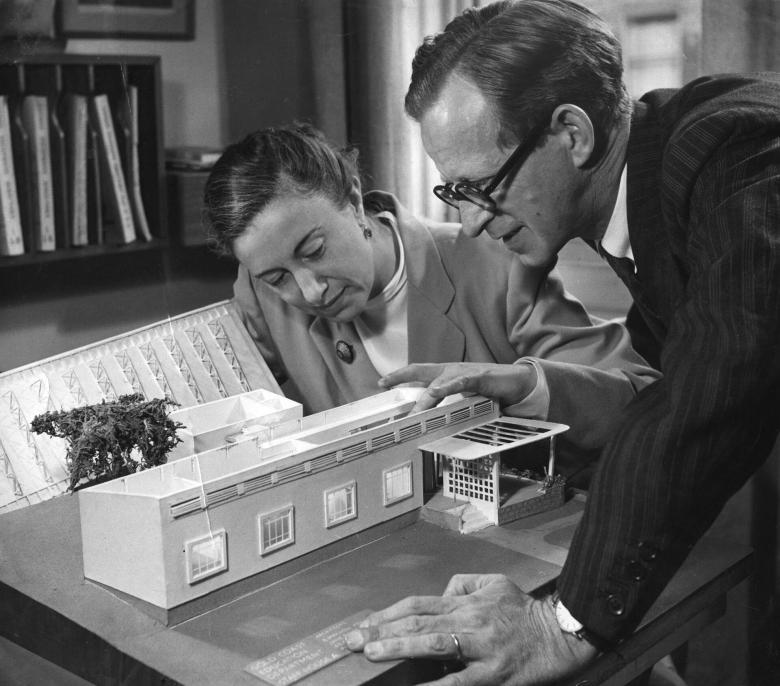Tropical Modernism: Architecture and Independence
As we look to a new future in an era of climate change, might Tropical Modernism, an architectural style developed in the late 1940s, serve as a useful guide?
Tropical Modernism was Britain's unique contribution to International Modernism – a colonial architecture, developed by British architects Jane Drew and Maxwell Fry, against the background of anti-colonial struggle in India and West Africa in the late 1940s. This exhibition looks at the colonial origins of Tropical Modernism in British West Africa, and the survival of the style in the post-colonial period when it symbolised the independence and progressiveness of newly independent countries like India and Ghana.
The exhibition includes models, drawings, letters, photographs, and archival ephemera documenting the key figures and moments of the Tropical Modernist movement. It begins with A Revolution in Architecture, introducing Jane Drew and Maxwell Fry, who adapted a utopian Modernist aesthetic that valued function over ornament to the hot, humid conditions of the region. When stationed in the Gold Coast, now Ghana, they created buildings designed to provide comfort, mainly to British administrators, and their buildings for Africans were intended to offset calls for independence.
Hidden Figures focuses on the African architects, including Theodore Shealtiel Clerk and Peter Turkson, that worked with Fry and Drew, and whose contribution is only now being recognised. This section also explores how African art and motifs were appropriated by European artists, and played a key role in the development of a Modernist aesthetic in the early 20th century.
The Winds of Change explores how Tropical Modernism developed against the backdrop of political unrest, spotlighting the aftermath of the Second World War, when many colonies wanted recognition for their contribution to the war effort by being granted independence.
Section 2: Temples of Modern India explores how Jane Drew and Maxwell Fry were recruited in 1950 by newly sworn-in prime minister Jawaharlal Nehru to build a new city at Chandigarh, in the foothills of the Himalayas, which would become independent India's first large-scale modernist project. They invited French architect Le Corbusier, one of the most influential architects and urban planners of the 20th century, to join them.
A Living Architecture School documents the work and achievements of Indian architects who joined the Chandigarh team, including Aditya Prakash, and Sikh model maker Giani Rattan Singh, who worked with Le Corbusier to translate his drawings into three dimensions but is little recognised in histories of Chandigarh and Modernism.
Nehru's Vision of Modernism is spotlighted in the next section, which influenced India for two decades, played out against a battle between modernists, who advocated an international, avant-garde approach to architecture that radically departed from the past, and revivalists, who wanted architecture to be more clearly Indian. Many government officials called for a national policy on architecture that would encourage the quotation of traditional motifs.
Section 3: Ghana, Land of Freedom looks at how Kwame Nkrumah, Ghana's first prime minister following independence from Britain, reappropriated Tropical Modernism as a visible symbol of the internationalism and progressiveness of his country. Nkrumah invited Ghanaian architects, like Victor Adegbite, back from the United States to create the architecture of modern, independent Ghana, building beacons for his idea of a free and united Africa. He also established an architecture school that allowed a future generation of architects to be trained at home, rather than abroad.
Following independence, Nkrumah sought to define a new African identity that could transcend national borders. This included the arts, music and, importantly, architecture. To celebrate independence, Nkrumah commissioned Victor Adegbite to design Black Star Square, a parade ground built in Accra on the colonial playing fields.
Section 4: The Legacy of Tropical Modernism includes an immersive three-screen film shot in Ghana, featuring panoramic portraits of 16 key remaining buildings including a Community Centre in Accra by Fry and Drew and Unity Hall at KNUST in Kumasi by John Owusu-Addo. Interviews with surviving protagonists including 95-year-old architect Owusu-Addo, who trained in London and attended the Department of Tropical Studies before returning to KNUST to build and teach, and Samia Nkrumah, a politician and the daughter of Ghana's first President Kwame Nkrumah, are interspersed with archival footage showing the buildings as they were first used and situating the architecture in the politics of the time.

Jane Drew and Maxwell Fry with a model of one of their many buildings for the Gold Coast, 1 945. Image courtesy RIBA
- When
- 2 March to 22 September 2024
- Where
-
V&A South Kensington
Cromwell Road
SW7 2RL London, Great Britain - Organizer
- Victoria and Albert Museum
- Links
- Tickets
More information
Magazine
-
Building Bridges with Chris Luebkeman
1 day ago
-
Winners of 2024 EU Mies Awards Announced
2 days ago